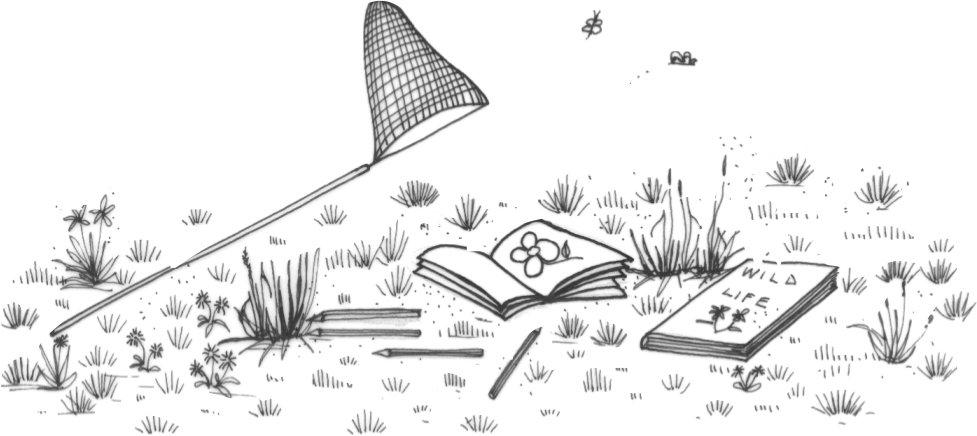WHILST BEING GUIDED along the educational path, children at the village school discover that lessons can proceed in a multitude of fascinating guises, with plenty of opportunities to exercise youthful high spirits. We were happy to become part of this process.
The first class to visit us was, appropriately enough, the youngest. Their classroom topic was ‘animal homes’ and we were to provide the fieldwork. A group tour of inspection began with a hedgehog nestbox in our log pile. Being early October there was no hedgehog in residence, but a multitude of woodlice, beetles and worms hiding beneath the logs were greeted with great enthusiasm by the children and carried carefully to their long-suffering teachers. Oak galls on low branches were displayed as now empty homes of gall wasp grubs, and the tale of how I was hoeing the hedgerow only to disturb a bees nest and have to run for shelter caused several children to request a repeat performance. Spiders’ webs were conveniently located at child height along the fence, together with a mysterious small tunnel dug beside a fencepost, for which guesses were invited as to what creature might live there.
The badgers’ tunnel through the impenetrable blackthorn bushes was peered down with interest, and proof of ownership had been kindly supplied the previous night when a badger left a clear broad pawprint in a patch of sand placed near the sultanas dish for that very purpose. The successful expedition returned cheerfully to the classroom to discuss and draw their discoveries.
In early December we replanted some of our sturdiest new trees with each school class. The weather was dull, but the atmosphere was very cheerful as we inserted trees, shovelled and stamped earth, applied bamboo canes and rabbit-collars, and fell down holes. Luke Williams, the Assistant Ecologist, duly arrived to capture the moment on video. I gave every child an acorn to plant in their own gardens, but the most popular moment was when I gave out sweets as a reward for a job well done.
To give central points of interest to the two ‘sitting down circles’ mown in summer for the schoolchildren beside the grass paths, we thought simple sculptures would be fun. Accordingly we visited the local garden centre and studied their rockery stones. Lacking a supply of marble, or Leonardo da Vinci to go with it, we plumped for two giant pebbles, each about a foot in length. This involved lining up a variety of pebbles to study through half-closed eyes, from various angles, to see if they resembled any animal shapes. It tended to confuse passing sales assistants.
Eventually, however, we settled on our two pebbles and took them home for painting. One was destined to become a rabbit, the other a badger cub. Mike christened the badger Rocky, which inevitably led to us calling the rabbit Roxy. They were far from fine art, but jolly, and the children approved.
A class of seven-year-olds visited in June. Perched on and around the bench and table, the children enthusiastically volunteered news about nature they had observed in their own gardens, then asked all manner of questions on topics from butterflies to badgers, toadstools to trees, plus everything else in between. Then they all went off to seek things out for themselves. I was kindly invited into their classroom later to see the impressive results of their efforts, where paintings, poems and prose adorned the walls in profusion.
As a result of being able to keep fairly accurate records of when our badgers appeared for their supper, we were able to offer the schoolchildren the opportunity to come badger-watching with their mothers in the summer. This was on the understanding that they might well have to sit still for an hour and even then perhaps not see anything. Some of the first pupils to take us up on this were Danielle and Jenni and their mums.
We were expecting the badger to arrive about 10.00 p.m., going on current form, but when we arrived at 9.00 p.m. our regular visiting badger was already at the dishes. She ran off on seeing us and we tiptoed into the shed hoping for her return. An hour later we were just about to give up and go home, when not one but two badgers arrived. They put on a great show between them, munching happily, strolling around and drinking water from the bird-bath. An entertaining half-hour which we all enjoyed, not least the badgers.
Over the years, thanks to the inventiveness of their teachers, local children’s lessons have benefited in many ways from our little area of wilderness. Natural history study might well have been anticipated, but scientific experiments, plus mathematical calculations such as working out the average height of a clump of lofty teasels, were more unexpected.
Projects such as inventing plans for new nature reserves, produced some very comprehensive schemes with innovative ideas from the children. We’ve been included in an orienteering exercise and a geography video. Map-making of half-an-acre is not as simple as it sounds when the grass is half as tall as you are and it is impossible to get a clear view from one end of the field to the other. Art and creative writing sessions have produced many a masterpiece, when opportunities have been perceptively offered by teachers for children to stop, look and listen to the natural world.
